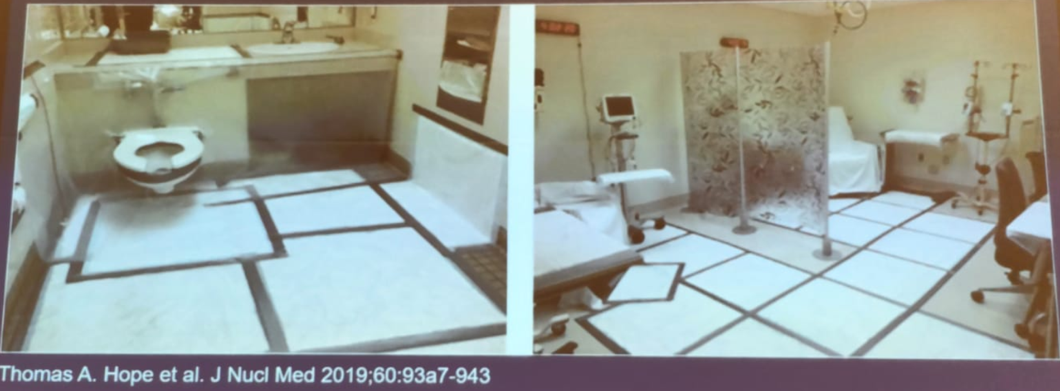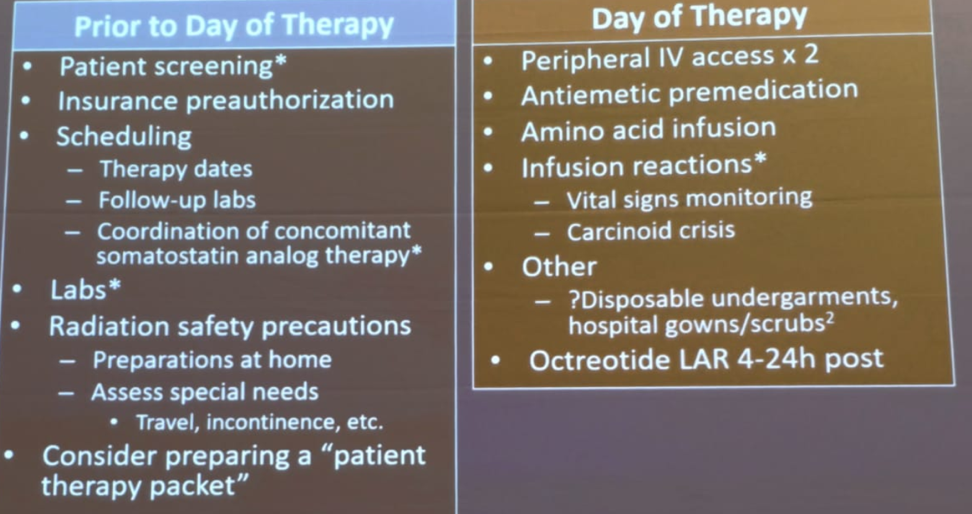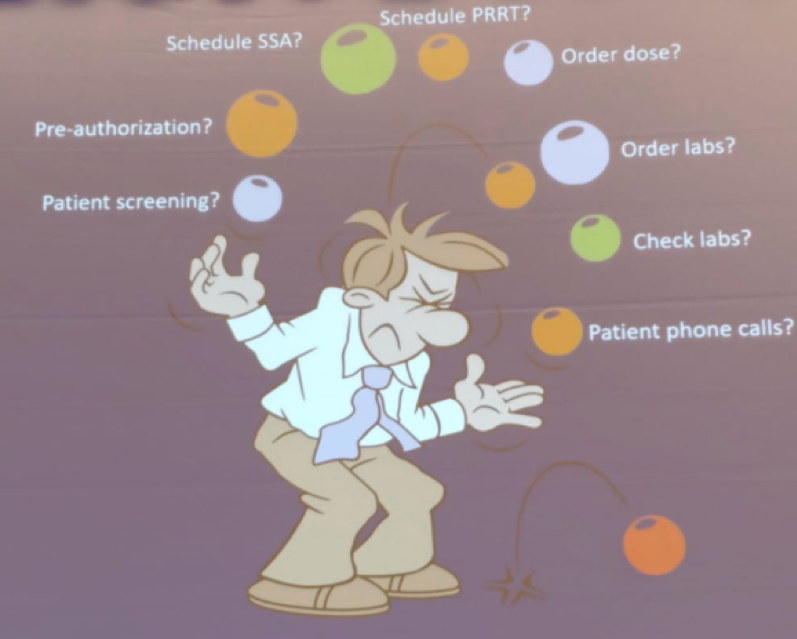The example she used throughout her talk was Lutetium-DOTATATE treatment. This is a radiolabeled somatostatin analog, FDA-approved in January 2018, for the treatment of somatostatin receptor-positive gastroenteropancreatic neuroendocrine tumors (GEP-NETs), including foregut, midgut, and hindgut neuroendocrine tumors in adults. The approval of this medication was based on data from NETTER-1 (NCT01578239) study1, a randomized, multicenter, open-label, active-controlled trial in 229 patients with progressive, well-differentiated, locally advanced/inoperable or metastatic somatostatin receptor-positive midgut carcinoid tumors.
In her center, Dr. Kwak described that this peptide receptor radionuclide therapy (PRRT) was given at 200 mCi IV every 8 +/- weeks for 4 cycles. It is always administered with:
- Amino acid infusion for renal protection
- Antiemetics for nausea/ vomiting associated with amino acid infusion
- Somatostatin analog therapy every 4 weeks
The location where treatment is provided is extremely important and Dr. Kwak’s talk focused on the important factors that need to be considered when choosing the location. The potential treatment location options include:
- Nuclear medicine department
- Outpatient Oncology infusion clinic
- Combination of both
Some important location considerations include making sure there are a designated therapy patient bathroom and the number of therapy patients per day.
Dr. Kwak then described some of the main advantages and disadvantages of these different treatment locations:
- Nuclear Medicine department advantages include:
- Trained radiation safety personnel
- Radioactive Material Program Licensing (RAML) coverage
- The potential for a growing theranostics clinic within the department
The disadvantages include:
- Need for dedicated treatment space
- Need for nurses trained in chemotherapy patient management
- The main advantages of performing this treatment in the oncology infusion clinic include:
- The fact there are Oncology nurses present, trained in chemotherapy, infusions, complications, and patient monitoring
- Dedicated treatment space with +/- dedicated restroom
The disadvantages include:
- Need for radiation safety training of the staff
- Radiation safety issues/contamination issues
- RAML issues
When initiating a designated clinic to perform treatment with radiopharmaceuticals there are several regulatory and radiation safety issues that must be considered:
- Contacting the radiation safety officer (RSO) and acquiring the RAML
- Figuring what to do and how to handle the radioactive waste – formulating a storage and disposal plan
- Make sure all staff have undergone radiation safety training
- Preparation of an infusion room and designated bathroom
The initial steps needed to prepare the pre-therapy room include protective covering of potentially contaminable surfaces (infusion room, dedicated patient bathroom with paper, disposable underpads and/or plastic wrap). This should all be done under the guidance of the radiation safety officer (Figure 1)
Figure 1 – An example of how to prepare the room for therapy:
Dr. Kwak provided a complete list of patient care preparation that needs to be followed on the day before and on the day of therapy (Table 1).
Other important factors to consider were to obtain insurance pre-authorization, and acquire the required infusions to be given together with therapy:
- Amino acid infusion for renal protection, which reduces the radiation dose to the kidney by 9-53%
- Anti-emetic premedication regimen (5-HT3 antagonist, NK1 receptor antagonist, and H2 receptor antagonist)
Table 1 – Patient care preparation:
According to Dr. Kwak, initiating such a service in the hospital from scratch is complex and involves “juggling” many issues (Figure 2). A key imperative factor that will enable success in this project includes adding a designated role of the nurse navigator. The nurse navigator will be able to significantly help the clinic perform better and will oversee:
- Initial referring screening
- Scheduling therapy consults
- Scheduling follow-up labs
- Train other nurses for Peptide receptor radionuclide therapy
Summarizing her talk, Dr. Kwak recommends evaluating the institution’s current resources to locate the physical space and patient care support team needed for therapy. Moreover, it is required to contact the radiation safety officer and start the inquiry regarding regulatory and radiation safety issues that need to be addressed. Finally, a plan for patient flow management needs to be created.
Figure 2- Juggling the many issues of creating a designated clinic to therapeutic radiopharmaceuticals:

Presented by: Jennifer Kwak, MD, Assistant Professor, Radiology-Nuclear Medicine, University of Colorado School of Medicine, USA
Written by: Hanan Goldberg, MD, Urology Department, SUNY Upstate Medical University, Syracuse, New York, USA, Twitter: @GoldbergHanan at the 2019 SNMMI Therapeutics Conference: Therapies, Theranostics, and Building Your Radionuclide Clinical Practice, October 25-27, 2019 in Las Vegas, Nevada
References:
- Strosberg J, El-Haddad G, Wolin E, et al. Phase 3 Trial of 177Lu-Dotatate for Midgut Neuroendocrine Tumors. New England Journal of Medicine 2017; 376(2): 125-35.


